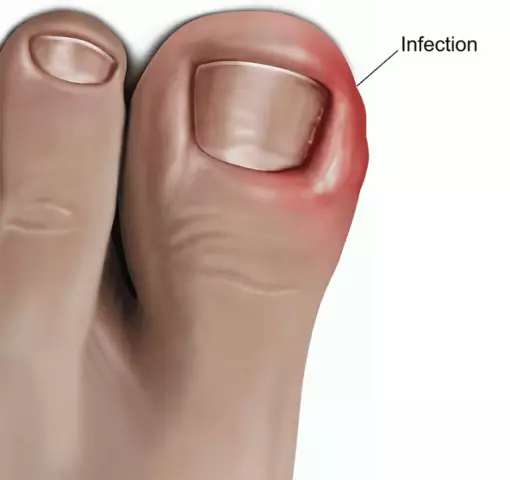- Author Rachel Wainwright [email protected].
- Public 2023-12-15 07:39.
- Last modified 2025-11-02 20:14.
Ingrown nail

A disease in which the nail plate grows into the lateral edge of the nail fold (the area of the skin around the nail) is called onychocryptosis (ingrown nail, onychogryphosis). An ingrown toenail can affect any nail plate, but more often the big toes are its favorite localization.
An ingrown toenail is a rather serious problem for any person who is faced with this pathology. As the nail grows into the thickness of soft tissues, it damages them, which leads to the formation of ulcers and tissue proliferation, the so-called growth of "wild meat". When walking, quite strong pain occurs, and the nail plate itself becomes faded, thickened and gradually begins to crack.
Causes of an ingrown toenail
- Hereditary predisposition. The onset of this disease is more often observed in people whose close relatives also suffer from it.
- Incorrectly fitted shoes. According to reviews, an ingrown toenail is most often found in people who prefer to wear tight and tight shoes. This leads to squeezing of the fingers, and as a result, the nail plate begins to grow incorrectly.
- An ingrown toenail is often the result of an injury.
- A fungal infection of the nail plate can lead to the development of an ingrown nail.
- The most common cause of an ingrown toenail is improper toenail trimming.
Ingrown toenail treatment
If your nail is just beginning to grow into soft tissue, then the disease can be treated at home using conservative methods:
1. Gently trim the nail in a straight line. Never cut it too short. it only enhances ingrowth. File the corners of the nail slightly with a file to make them less irritating to the tissue of the nail roller.
2. To reduce the severity of the inflammatory process and associated swelling, do warm salt baths with feet. After finishing the water procedure, gently blot the damaged area and lubricate it with tea tree oil, which has excellent disinfecting properties. Then very carefully lift the nail plate and insert a small cotton flagellum (turunda) under it. These procedures should be performed daily for two weeks.

3. If your nail plate is very hard, and you cannot slip cotton turunda under it, then to soften it, you can use a compress with butter or aloe leaf, applied for a day.
4. For the treatment of an ingrown nail, you can use various antibacterial ointments (Vishnevsky liniment, Levomikol, etc.). They are good at eliminating inflammation, relieving pain and preventing the overgrowth of granulations ("wild meat").
5. According to reviews, an ingrown nail is best treated conservatively as follows: once a month, file with a nail file or a needle file the thickness of the nail from its very base to the tip (the nail must first be steamed) along the midline. It should be cut down to about half of its thickness. After several procedures, the nail plate becomes quite transparent, and the nail bed even begins to shine through it. The sawn-off nail begins to grow together, pulling from its edges to the middle, as a result of which, over time, it completely stops growing into the tissue of the nail roller.
Ingrown toenail: surgery
Unfortunately, conservative treatment of an ingrown toenail does not always lead to a lasting positive effect. In these cases, to relieve patients of discomfort and inconvenience, doctors recommend surgical treatment - removal of an ingrown nail. Such operations are performed on an outpatient basis and under local anesthesia. After them, relapses of the disease are practically not observed, provided that you wear the right shoes.
During the operation, the ingrown nail, or rather its edge, is excised. In addition, the surgeon also excises the section of the nail root and the nail bed to the required width, which guarantees the absence of subsequent relapses of the disease.
In some situations, it is possible to gently remove a small area of the nail roll, which allows you to maintain the normal shape of the nail.
In recent years, the removal of an ingrown nail has been increasingly performed using laser technology. Such operations are more easily tolerated by patients and give a low percentage of postoperative complications.
YouTube video related to the article:
The information is generalized and provided for informational purposes only. At the first sign of illness, see your doctor. Self-medication is hazardous to health!






